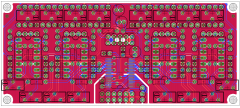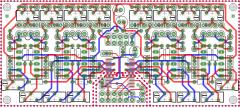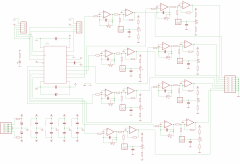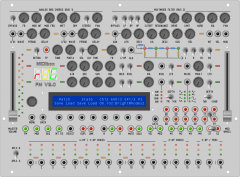I would like to re-route the AOUT_NG board for use in Eurorack systems. I imagine two stacked boards with a final panel of 6-8 HP.
The first contains PCB-mount 3.5mm sockets for CV 1-8, Gate 1-8 and DIN SYNC. I don't there's room for proper 5-pin DIN sockets. A DB-25 connector would be used to bring gates, DIN-sync and J19 from e.g. a MB-SEQ or a standalone Core for MIDIBox CV. I would think about simple emitter follower/common collector circuits to indicate "Gate On" states. LEDs could also be useful for CV indication, especially in negative mode.
The second board would be a clone of the current AOUT_NG circuit (assuming that this is okay) except fitting onto a rectangular PCB. The power would come from the Eurorack buss, and would probably need extra filtering and/or optoisolation to keep digital noise out of the rails. Either sandwich-style or DIL connectors would bridge the two boards.
The benefits I can see are: easier power requirements for a MB-SEQ and a more useful layout of connectors for patching as part of a modular system. I already have a DB-25 breakout board that buffers and level shifts gates inside the SEQ enclosure.
Anyway, just a diving off point for further discussion. I firstly need a copy of the .sch file for the AOUT circuit, otherwise I will have to translate it from the .pdf diagram. I did try to contact Seppoman but he doesn't seem to visit here much any more.






